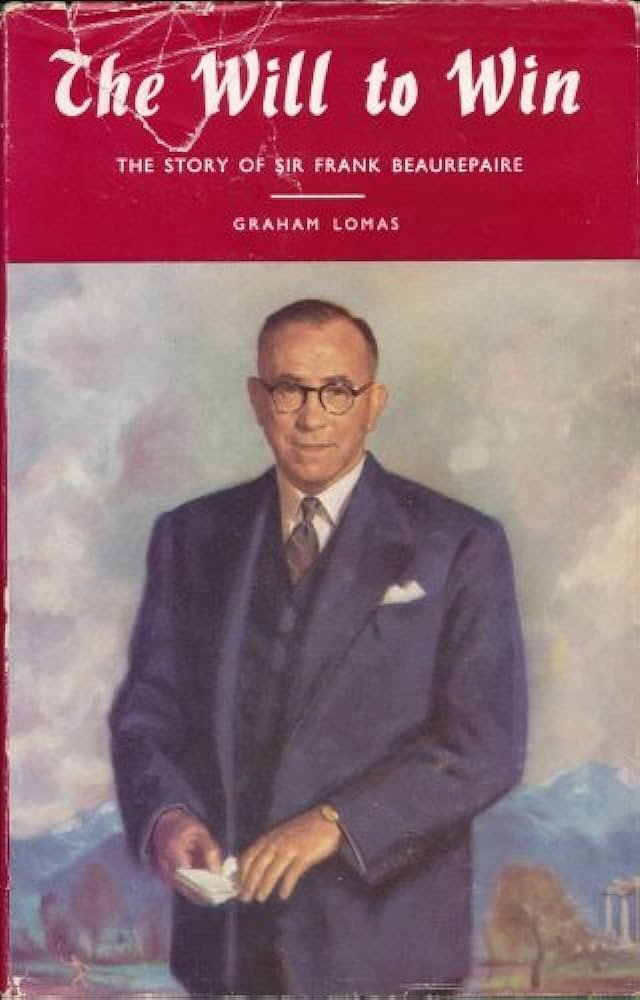Graham Lomas, The Will To Win: The Story of Frank Beaurepaire (1960)
Beaurepaire is a name that has long been synonymous with tyres in Australia, but few now remember that the company’s founder was one of our nation’s earliest Olympic heroes. Indeed, even Beaurepaire’s Footscray tyre factory, which Menzies helped to open as acting premier in 1934, was named the Olympic Tyre Factory.
Beaurepaire was a close contemporary of Menzies. Born in Melbourne in 1891, he attended Wesley College forging a name for himself as a sportsman that would have been much revered when Menzies himself enrolled in the school. A powerful swimmer, Beaurepaire won his first state title at the age of 16. In 1908 he won three titles in the national championships at Perth, earning a trip to London for the Olympic games that same year. So early was this in the history of competitive swimming that the ubiquitous form of ‘freestyle’ had not yet developed. Hence the term meant what its name implied, that you could swim however you chose. Beaurepaire developed ‘a modification of the popular trudgen stroke, [which] proved effective over both short and long distances’.
Beaurepaire’s athletic talents were by no means confined to swimming either, as he ‘indulged an interest in motor cycling with an attempt on the 24-hour endurance record, riding a Triumph around Albert Park Lake.’ His sporting career was interrupted by the outbreak of WW1, when he enlisted in the AIF. But the armistice of 1918 ushered in further Olympic appearances at Antwerp 1920, and Paris 1924. Though the experience was never quite as satisfying as it might have been, for despite holding 15 world records, Beaurepaire never won an Olympic gold medal.
In the foreword to The Will to Win, Menzies marveled:
‘A man who swims in the Olympic Games as a boy of 17, finds himself two years later the outstanding swimmer in the world, beating his old records, another 10 years later and another 4 years after that once more swimming in the Olympic Games, is in our rather homely phrase “something out of the box”’.
Unsurprisingly, Beaurepaire initially found employment as a swim instructor. But in 1920 a Canadian acquittance helped convince him to get involved in the tyre repair business. By the early 1930s he had founded the Olympic Tyre and Rubber Co. Pty Ltd., in which Menzies became an early investor:
‘When he suggested to me that I should invest what to me was no small sum in the new company, I was as cautious as a Minister inviting a Member to put his question on the notice paper!’
But the company quickly became a major success, outdoing its very large foreign competitors. Although Menzies felt the need to sell his holdings when he became prime minister in 1939, it was a profitable investment while it lasted.
This was just one of many ways in which the two men interacted: They were both members of Melbourne’s famous Savage Club; Beaurepaire became Lord Mayor of Melbourne during the early period of WW2 and in that capacity greatly helped the Menzies Government with its fundraising and recruitment drives; and in more peaceful times the ex-athlete ‘played a dominant part in the obtaining of the Olympic Games for Melbourne’.
Tragically however, Beaurepaire would not live to see the hometown carnival. He passed away suddenly on 29 May 1956 – just a few months out from what must have been a long-time dream coming true. Nevertheless, his legacy lived on. For example, to this day the pool here at the University of Melbourne is named the Beaurepaire Centre to acknowledge both his sporting achievements and his philanthropy. Menzies lauded Beaurepaire as a ‘great Australian industrial pioneer’, who left the nation better than he found it.
Sign up to our newsletter
Sign up for our monthly newsletter to hear the latest news and receive information about upcoming events.


